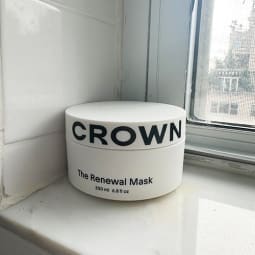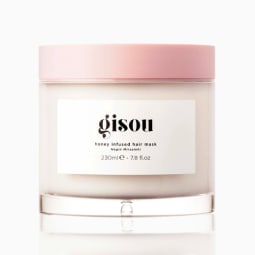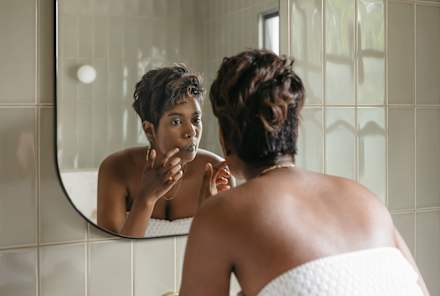Advertisement
12 Best Hair Masks For Damaged Hair Of 2023: Tackle Frizz, Breakage & More


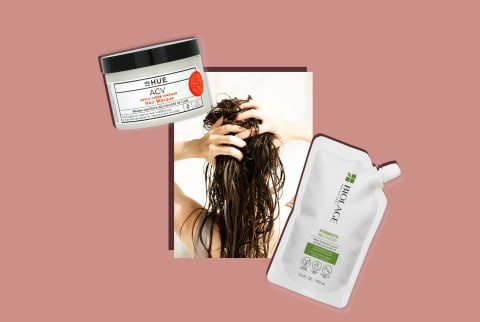
If you want silky, healthy hair (I'm assuming that's everyone here), daily maintenance is a given, but sometimes you do need to bring out the heavy hitters. Especially for those with damaged, brittle, and just generally stressed-out strands, targeted treatments can breathe some life back into your locks.
Enter, hair masks: These nutrient-dense concoctions are like Michelin star meals for your strands, but not all whip-thick formulas are created equal. (Damaged strands, you see, don’t all look the same!) If you’re hoping to send your mane some much-needed T.L.C., we’ve got you covered—these hair masks ahead will revitalize your thirsty tresses.
Sneak peek at the best hair masks for damaged hair of 2023
How we picked
Smart ingredients
Each product features innovative players known to help improve the strength of the hair fibers and rebuild broken bonds.
High-quality formulas
Damaged hair is especially screaming for moisture, so we made sure to include the most hydrating, high-quality options.
Tried & tested
We tested out products firsthand to see what worked and what didn't. Every single product comes with personal accounts and tips.
Variety
Some prefer overnight options, while others have no patience for marinating longer than three minutes. We made sure to include a variety of treatments here.
mbg's picks for the best hair masks for damaged hair of 2023
Best for frizzy hair: Vegamour HYDR-8 Deep Moisture Repair Hair Mask
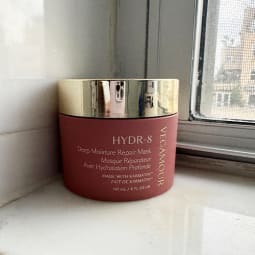
Pros
- Reduces frizz for 72 hours
- Instantly softens & smooths
Cons
- Contains fragrance
Key ingredients:
KarmatinMilk thistleMarula oilMoringa seed oilPrice:
$52This mask instantly gave me smooth, salon-quality hair. And I’m not alone: According to clinical results from the brand, the mask delivers 15x hydration and 3x stronger stands after just one use, with frizz reduction up to 72 hours.
The formula’s hero ingredient is Karmatin, Vegamour’s signature vegan alternative to keratin and silicone. The biotechnology-derived ingredient (made from fermented silk protein) creates a mirror image of the amino acids that naturally occur in hair, and it remains attached to strands even after rinsing. And unlike silicones, Karmatin actually penetrates the hair shaft. Then there’s milk thistle to provide antioxidant protection and fend off UV damage, as well as cold-pressed, fatty acid-rich marula oil and moringa seed oil for a luxurious slip and shine. After testing Vegamour’s entire Hydr-8 range for eight weeks, this nutrient-rich mask quickly became a showertime staple.
Best for color-treated hair : dpHUE Apple Cider Vinegar Hair Masque
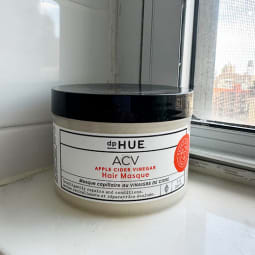
Pros
- Silicone-free
- Makes hair color way more vibrant
Cons
- Contains fragrance
Key ingredients:
Apple cider vinegarCoconut oilPanthenolAvocado oilSunflower seed extractPrice:
$44Bleach and chemical dyes can damage the hair over time: "When the hair is overprocessed, past its breaking point, the hair's bonds can be easily damaged and become extremely dried out," celebrity hairstylist Andrew Fitzsimmons previously told mbg. If your gorgeous color could use some coddling, try folding a color-safe hair mask into your routine.
dpHUE is known for their high-quality, color-enhancing offerings, and their apple cider vinegar-infused hair mask definitely fits the bill: It helps seal down the hair’s cuticle to enhance shine, and provides essential fatty acids and antioxidants to moisturize and strengthen strands.
What our tester says.
“I often find myself gravitating towards really dense hair masks,” says mbg beauty director Alexandra Engler. “Mentally I connect thick with it must be working. But the reality of it is that I have fine hair fibers, and really thick products tend to weigh my hair down. So I'm left to find light hair products that are able to be just as effective at delivering nutrients and hydration. This is truly one of my favorites. My hair feels so soft and weightless after using it. Plus, it helps bring vibrancy back to my hair—as someone who has spent many years color-treating their strands, I need as much help as I can get.”
Advertisement
Best for dry, brittle hair: Act+Acre Conditioning Hair Mask
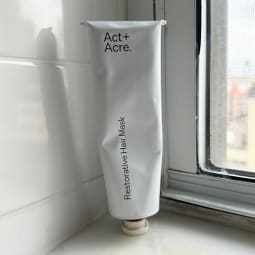
Pros
- Silicone-free
- Can use frequently in place of conditioner
- Can leave on for long periods of time
Cons
- Smaller size
Key ingredients:
PanthenolCastor oilGlycerinShea butterPrice:
$38With castor oil, glycerin, shea butter, and panthenol, this ultra-hydrating mask is like a feast for dry ends. It’s pretty thick, yet you could use it every wash day if you wanted to, especially if you have high-density hair. I only wish the bottle was a tad bigger—I run through it quite quickly!
What our tester says.
I’ll often use this mask in place of my regular conditioner. It’s so buttery and moisture-rich, yet it doesn’t weigh down my strands with frequent use. For an extra-deep treatment, I’ll wet my hair, run this hair mask through my strands from root to tip, then tie my lengths up in a clip for a couple of hours. (The ingredients are pretty simple and solely moisturizing, so you don’t need to worry about overloading your scalp or strands with protein.) Each time, I marvel at how soft my ends feel after finally rinsing out the solution.
Best budget: NatureLab. Tokyo Perfect Repair Treatment Masque

Pros
- Quick results
- Invigorating forest scent
Cons
- Contains silicones
Key ingredients:
Vegan keratinArgan oilPrickly pear oilPrice:
$19The first time I used this mask, I was truly in awe at how smooth and frizz-free my hair looked. But after taking a look at the menu of five-star ingredients, it’s not difficult to see why I immediately fell in love: There’s vegan keratin to rebuild hair bonds, argan oil to provide a silky shine, and prickly pear oil for a heaping dose of antioxidants.
And for any impatient folks among us (self very much included), you only need to let the formula sink in for three to five minutes before rinsing—just enough time for a quick body scrub and shave. A few minutes is really all you need to see those game-changing results, I can assure you.
Advertisement
Best splurge: K18 Biomimetic Hairscience Leave-In Molecular Repair Hair Mask
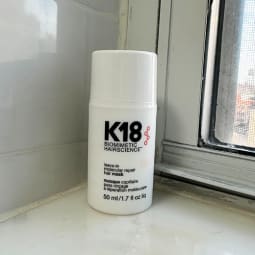
Pros
- Patented repairing technology
- Clinically-backed results
Cons
- Contains fragrance
Key ingredients:
Patented K18PeptideHydrolyzed wheat proteinHydrolyzed wheat starchPrice:
$75This leave-in treatment instantly reached cult-status, and for a good reason: The brand’s patented peptide technology works to rebuild hair at the molecular level in just four minutes—yes, you read that right. That biomimetic peptide actually mimics the hair’s natural structure, so it can slide in and reconnect broken hair bonds, thus leading to stronger, more resilient strands.
That said, you need to skip conditioner entirely to use this treatment: Conditioner leaves a film on your strands that will keep the peptide from penetrating into the hair shaft. Give your scalp a good scrub to lift any buildup, apply the K18 leave-in, then proceed with your regular hair styling routine (feel free to add in any products after the four minutes are up).
The brand recommends using it for 4 to 6 washes if you have really damaged hair, then only as needed. As Fitzsimons tells us about protein treatments: "It is safe to use a protein treatment weekly for the first month of using it. After that first month, I wouldn't recommend using it more than once or twice a month, as adding too much protein in your hair can leave it feeling brittle and susceptible to breakage."
Best for thick hair: Biolage Strength Recovery Deep Treatment Mask for Damaged Hair
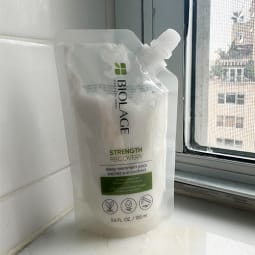
Pros
- Budget-friendly
- Rich formula
- Smells amazing
Cons
- Smaller pouch
- Contains fragrance
Key ingredients:
GlycerinShea butterSqualanePrice:
$17Thicker, coarser hair is often prone to dryness, which is why you want to look for “a rich and creamy formula that has natural emollients that protect and help repair your hair, like squalane,” says celebrity hairstylist Cynthia Alvarez. This Biolage concoction contains olive-derived squalane, which not only infuses the strands with moisture but also acts as an alternative to silicones, so you get the same silky shine without the buildup.
What our tester says.
This is the hair mask I’ll use every time I blow-dry. Heat harms your hair, so you can bet your bottom dollar I’ll do my best to mitigate the damage. The ultra-moisturizing, buttery formula cradles my strands in moisture, so each blowout looks fluffy and full. If you are one to use hot tools on occasion, I encourage making this mask part of your regular rotation.
Advertisement
Best for breakage: Olaplex No. 8 Bond Intense Moisture Hair Mask
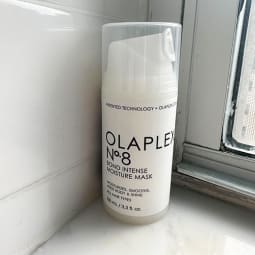
Pros
- Contains patented hair repair technology
- Softens & immediately adds shine
Cons
- Contains fragrance
Key ingredients:
Avocado oilOlaplex bond-building technologyMeadowfoam seed oilRice bran oilPrice:
$30We can’t have a hair mask roundup without mentioning Olaplex! There’s a reason why this buzzy brand has captured the hearts of countless beauty folks: It seriously works. The patented bond-building technology noticeably repairs strands, resulting in stronger, shinier, and visibly healthier hair.
A quick note: You may have seen online hacks and routines that involve leaving on an Olaplex mask all day long (some even use it to slick back their hair in a pony or bun). The label advises you to rinse after 10 minutes, and we suggest following the brand’s instructions. If you leave on some treatments for too long, those benefits can potentially start to backfire. And as we mentioned up top, you don’t want to overdo it on the bond-builders; stick to once or twice a month.
What our tester says.
This mask is mbg assistant beauty editor Hannah Frye’s go to pick: “I keep this hair mask in my shower at all times, in case of emergency. By that, I mean when my hair has been blow-dried, flat-ironed, slicked back, and hair sprayed a little too often,” she says. “After a deep cleanse and a generous application of this mask, my strands come back to life almost instantly. Plus, it makes my hair feel soft even after a second and third wash.”
Pros
- Lightweight yet hydrating
- Refreshing scent
- Chic aesthetic
Cons
- Contains fragrance
Key ingredients:
Tsubaki seed oilYuzu fruit extractPrice:
$58If you have fine locks yearning for moisture, you can’t go wrong with this weekly ritual. With tsubaki seed oil and yuzu fruit extract, the blend deeply hydrates and strengthens without weighing down strands. Yuzu is also notably high in potassium, which helps aid in hair growth.
What our tester says.
Crown affair founder Dianna Cohen has some of the silkiest, fluffiest strands in the game (IMO), so I’ve pretty much copied her entire hair care routine at this point. (Her clip-and-twist air-dry technique is now one of my nonnegotiable steps.) Her mask truly serves as a moment of self-care—the cool, light fragrance transforms my shower into a spa—and it leaves my hair touchably soft.
Advertisement
Best for curls: Bread Beauty Supply Hair Mask Creamy Deep Conditioner
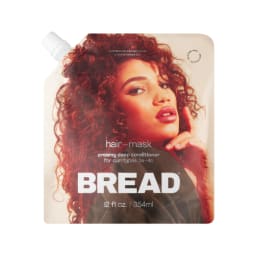
Pros
- Silicone-free
- Great detangler
- Leaves curls soft & juicy
Cons
- Contains fragrance
Key ingredients:
Shea butterKakadu plumBorage oilCarrot seed oilPrice:
$28This is truly the Goldilocks of hair masks—not too heavy, yet not too light—so you can use it every single wash day, or on occasion an intensive treatment. You can wash it out completely, or let some lingering residue sink in as a leave-in treatment. It’s meant to be versatile, and those with thirsty curls will especially love the hydrating kakadu plum, borage oil, shea butter, and carrot seed oil.
Pros
- Can be used on wet or dry hair
- Lightweight yet conditioning
- Restores shine
Cons
- Contains fragrance
Key ingredients:
Coconut oilCastor oilHydrolyzed wheat proteinMirsalehi honeyPrice:
$57Honey is a hair care hero (that’s why you can find it in a number of DIY hair masks; we’ll explain more in a moment!). It’s known for its humectant and antioxidant properties, and it’s rich in minerals and amino acids to fortify damaged strands.
No, you can’t fully repair split ends (the best you can do is trim them off and start anew), but this glossy, emollient-rich formula disguises them quite beautifully. With coconut oil, castor oil, and hydrolyzed wheat protein, it will surely prevent frays from making an appearance.
Advertisement
Best overnight: Briogeo Don't Despair, Repair! Strength + Moisture Leave-In Spray Mask

Pros
- Very user-friendly
- Lightweight
- Doesn’t leave behind any residue
Cons
- Smaller bottle
Key ingredients:
PanthenolArgan oilAlgae extractPrice:
$29As a general rule, you’ll want to follow the directions on your hair mask. If it says to rinse out after 10 minutes, don’t leave it on all night long (unless otherwise instructed by a professional). If you’re looking for a treatment to coddle your tresses overnight, look for a formula with leave-in capabilities, like this spray mask.
Briogeo’s Don't Despair, Repair! range is beloved for amino acid-rich infusions (this one features micro-encapsulated argan oil, algae extract, and panthenol), but I especially adore the ease of this spray-on treatment. The fine mist effortlessly coats your strands in moisture—without making a mess of your bathroom counter or pillow.
Best for hair growth : adwoa beauty Baomint Deep Conditioning Treatment
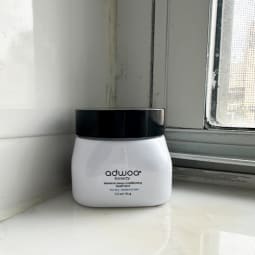
Pros
- Contains certified organic ingredients
- Cooling & refreshing experience
Cons
- Essential oils can be irritating for sensitive scalps
Key ingredients:
Coconut oilShea butterBaobab oilSweet almond oilLavender oilRosemary oilPrice:
$39In addition to moisturizing players, like shea butter, coconut oil, baobab oil, and sweet almond oil, this nutrient-rich mask contains scalp-stimulating essential oils, like lavender and rosemary oil. Why are these important? Well, stimulating the scalp helps deliver vital nutrients and oxygen to the hair follicles, which helps with hair growth.
Rosemary, in particular, has been clinically shown to boost hair growth: Holistic plastic surgeon Anthony Youn, M.D., even calls the blend "a very reasonable option for people who want to stay natural and have some thinning hair issues" on the mindbodygreen podcast. So if you’re struggling to grow weak, damaged strands, this is quite the nourishing mask to choose.
How to choose
Our list of hair masks above should certainly get you started, but if you’re wondering how your own go-to formula measures up, consider the below criteria:
Look for protein
Your hair is actually made up of protein—about 95% of it, in fact, comprises the protein keratin. "We can't recreate the exact protein that is in our hair [with topicals], but synthetic and naturally sourced proteins can repair and stand in place like a Band-Aid," explains NYC-based hairstylist Matt Newman.
Look for buzzwords like keratin, biotin, hydrolyzed quinoa, amino acids, bond-building, or silk protein on your hair masks if you’re interested in rebuilding those broken hair bonds. After all, "A good protein treatment can aid in the repair of severely damaged hair, hair growth, and the penetration and healing of a dry, flaky scalp," says celebrity hairstylist Annagjid "Kee" Taylor.
However, you can overdo it on protein treatments, which makes your hair look dry and brittle (it’s a delicate dance). Here’s how to tell if your hair actually needs protein and how to spot protein overload.
Prioritize humectants & emollients
Humectants are water magnets that attract hydration to the hair shaft, while emollients help soften and repair hair bonds. “Just like your plants need water, so does your hair,” says trichologist and celebrity hairstylist Helen Reavey, founder of Act+Acre, who recommends glycerin to attract moisture. (We’d also add aloe vera, hyaluronic acid, and panthenol to that humectants list.)
“Be on the lookout for emollients like shea butter, which is rich in fatty acids and vitamins that work to hydrate the hair and lock in moisture,” she adds. “Additionally, ingredients like argan oil, squalene, and meadowfoam seed oil are all extremely hydrating and will help to reduce the appearance of damage while adding shine.”
Limit silicones
Look, we’re not against silicones completely (aside from cyclic silicones). Some people love the silky-smooth aesthetic, and that’s OK! Just know that they’re not actually doing much for damaged hair.
“Many masks create the illusion of smoothness by using silicones, which form a waterproof seal around the hair to block out humidity,” says Reavey. “These seals build upon each other with continued use, weighing the hair down and making it increasingly difficult to receive moisture, creating flat and brittle hair.”
That’s not to say you should avoid them entirely; but if you’re dealing with damaged locks, you might want to prioritize fatty acid-rich oils and butters to nourish your strands.
4 DIY hair masks
No hair mask? No problem! You can easily whip up a conditioning confection with simple kitchen ingredients. We have a full list of hydrating treatments here, but you can check out some of our favorite quick recipes below:
Aloe vera mask
The famous skin healer is full of anti-inflammatory properties1 that make for a soothed, supple scalp. Because of its high water content, the gel is also super moisturizing.
- Apply pure, fresh aloe vera gel to clean strands from root to tip.
- Let it sit for 20 minutes max, then rinse thoroughly.
Coconut oil mask
Coconut oil makes a great pre-shampoo mask to protect hair from physical damage2 and friction. Not to mention, it’s chock-full of healthy fats and antioxidants.
- Take a dollop of coconut oil and warm it between your palms, then apply directly onto your hair. Start at the ends, and work your way up to the root.
- Let it sit for upward of 30 minutes, then thoroughly rinse out.
Honey mask
Honey has humectant properties, so applying it topically can help your hair and scalp retain moisture3.
- Mix ¼ cup Manuka honey with just enough water to turn it into a hair-conditioner-like consistency.
- Apply after shampooing just like you would a conditioner, but let it sit for 30 minutes.
- Rinse out with warm water.
Banana honey mask
Bananas are rich in silica4, a natural molecule that closely resembles silicone, so it can similarly help smooth frizz by sealing down the cuticle. And honey, as we mentioned, is great for hydration.
- Mash together 1 banana (or however many you have available) and a few drizzles of honey.
- Coat your hair, root to shaft, and let it sit for 15 minutes before rinsing out.
FAQ
Do hair masks fix damaged hair?
Well, yes, to an extent. “As our hair cannot regulate its own moisture, it is important to maintain proper hydration levels using three key substances: emollients, humectants, and occlusives,” says Reveay. “Hair masks typically include these ingredients, which work together to attract water molecules to the hair follicle, seal in moisture, and create a barrier to prevent water from escaping.”
While it isn’t possible to fully fix damaged hair, hair masks can help ease some of the signs (like breakage and dryness). While it isn’t possible to fully fix damaged hair, hair masks can help ease some of the signs (like breakage and dryness). “It provides a temporary solution,” says trichologist Bridgette Hill. “Think of snagging a piece of fabric and using a similar thread made of the same material to reinforce. Over time, the reinforcements create a superficial hold that allows the hair fiber to look and feel strong, beautiful, and shiny.”
What’s the best DIY mask for damaged hair?
We highly encourage checking out our full list of DIY hair mask treatments, but if you’re looking for a simple-yet-effective option, you can’t go wrong with aloe vera or honey. Both are brimming with antioxidants and humectant properties to protect and hydrate damaged strands.
Do you put a hair mask on wet or dry hair?
“Oil based hair masks should be used on dry hair because wet hair won’t allow the oil to be absorbed,” says Alvarez. (Remember: Oil and water do not mix.)
“For all other masks, apply on wet hair—it not only absorbs ingredients better than dry hair, but it also allows you to shampoo your hair beforehand, leaving [your scalp] clean. The absence of dirt and oil will also allow the ingredients in your mask to better penetrate into your hair shaft.”
Although, your hair texture and type of damage also play a role, as does your individual hair mask’s instructions. Your product will likely provide how-to instructions, so we recommend following those.
What does damaged hair look like?
“Damaged hair typically looks dry and dull, and often can result in breakage, split ends, frizziness, and rough/brittle texture,” says Reavey. “If you're experiencing any of these problems, your hair is likely damaged and in need of some added moisture! Excessive tangling and flyways are other signs of damage. You might notice your hair drying faster in areas.”
Can you fully repair damaged hair?
“Sadly, there’s no real way to heal and fully repair damaged hair,” says Alvarez. “For the most part, hair damage is permanent because hair is only a collection of dead cells that are not repairable. The only cure is time, regular trims, and preventative hair care, like hair masks and heat protection.”
As Hill states, “Hair is protein-ized threads, making it a literal fabric.” Treat it like you would a high-quality textile: Rather than tossing it in the wash, you might opt for a dry clean. With hair, you might care for it with a similar ritualistic approach, says Hill, and help your body produce more of its own “luxury fabric.”
The takeaway
If you’re dealing with damaged hair, might we suggest one of these hair masks? You’ll be sure to find a formula to meet your own strands’ demands: For those experiencing damage from dye, dpHUE’s ACV-infused number is a solid option; for those struggling with breakage, you can’t go wrong with using Olaplex. Regardless, all are of the highest quality with smart, targeted actives.
Consider them five-star banquets for your tresses—of course, that doesn’t mean you should ignore a daily diet. Make sure you have some hydrating shampoos and conditioners on rotation, and your damaged hair will look lively in no time.
